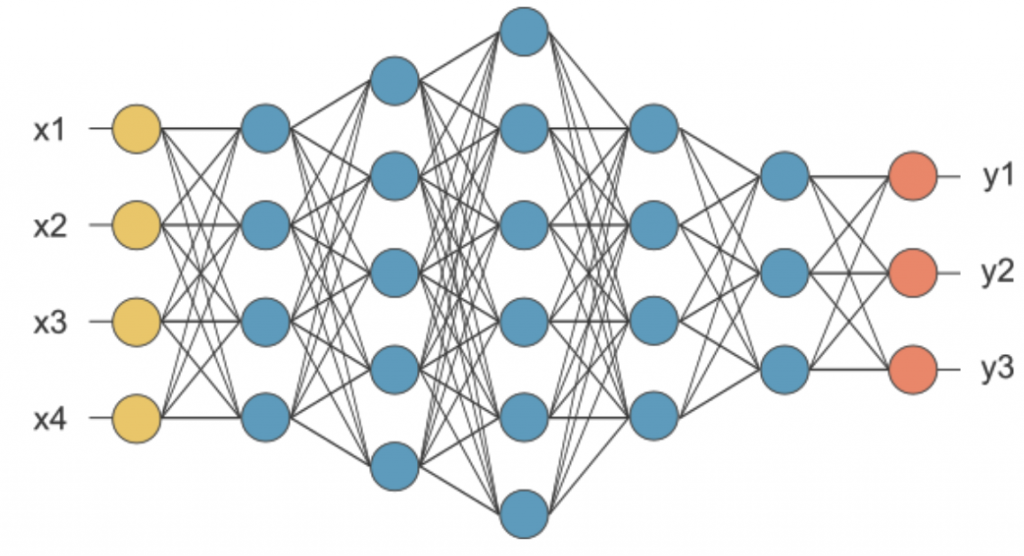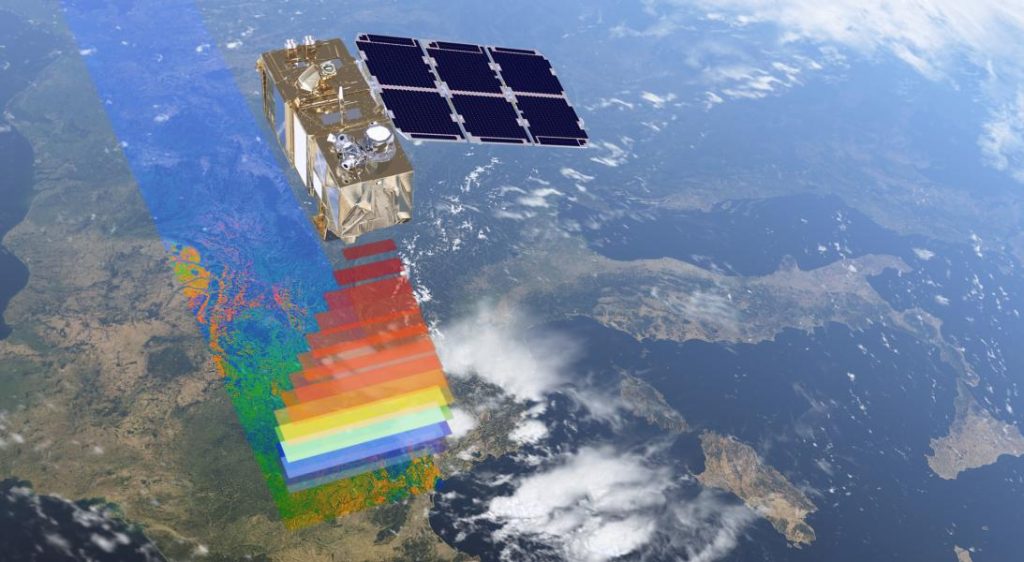Machine Learning

This is our most recent research topic, where we apply deep learning to problems at the boundary between signal processing and computer science. We develop and train innovative neural network architectures for computer vision tasks. Most of our work is focused on the solutions of inverse problems in imaging, including denoising of optical images and point clouds, despeckling of SAR images, super-resolution, point cloud completion, etc.. We also work on representation learning exploiting the theory of graph neural networks, hyperbolic learning and multimodal data.
Recent results:
- A graph GAN with application to point clouds. See: D. Valsesia, G. Fracastoro, E. Magli, “Learning Localized Generative Models for 3D Point Clouds via Graph Convolution”, ICLR 2019.
- Graph-convolutional image denoising. See: D. Valsesia, G. Fracastoro, E. Magli, "Image denoising with graph-convolutional neural networks" (Best paper award ICIP 2019), "Deep Graph-convolutional image denoising"
- Multi-image superresolution. See: A.B. Bordone, D. Valsesia, G. Fracastoro, E. Magli, "DeepSUM: Deep neural network for Super-resolution of Unregistered Multitemporal images", IEEE Transactions on Geoscience and Remote Sensing 2020 (winner of ESA PROBA-V challenge)
- Deep point cloud denoising: F. Pistilli, D. Valsesia, G. Fracastoro, E. Magli, "Learning graph-convolutional representations for point cloud denoising", ECCV 2020
- Deep point cloud denoising: A. Montanaro, D. Valsesia, E. Magli, "Rethinking the compositionality of point clouds through regularization in the hyperbolic space", NeurIPS 2022
- Deep point cloud denoising: E. Aiello, D. Valsesia, E. Magli, "Cross-modal Learning for Image-Guided Point Cloud Shape Completion", NeurIPS 2022
Forensics and Security
Regarding forensics, the IPL group has been active in camera identification using photo-response non-uniformity (PRNU) of camera sensors. We have proposed an innovative compressed representation of PRNU based on random projections, which can reduce storage requirements up to two orders of magnitude. The proposed representation is at the core of a fast retrieval technique for identifying, in collections of millions of pictures, all the photos acquired by a given camera. Moreover, we have recently demonstrated how to use it to build secure authentication protocols based on camera sensor recognition, and we are currently working on image clustering based on camera sensor. Our group also made important theoretical contributions on the security of random projections as a privacy-preserving layer, showing that under practical assumptions they can provide useful secrecy guarantees. We are currently working on extending those results to finite precision representations.

Relevant publications:
- D. Valsesia, G. Coluccia, T. Bianchi, E. Magli, User Authentication via PRNU-based Physical Unclonable Functions, IEEE Transactions on Information Forensics and Security, vol. 12, no. 8, pp. 1941-1956, Aug. 2017.
- T. Bianchi, V. Bioglio, E. Magli, Analysis of One-Time Random Projections for Privacy Preserving Compressed Sensing, IEEE Trans. on Information Forensics and Security, vol. 11 n. 2, pp. 313-327, Feb. 2016.
- D. Valsesia, G. Coluccia, T. Bianchi, E. Magli, Large-scale image retrieval based on compressed camera identification, IEEE Transactions on Multimedia, vol.17, no.9, pp.1439-1449, Sept. 2015.
- D. Valsesia, G. Coluccia, T. Bianchi, E. Magli, Compressed Fingerprint Matching and Camera Identification via Random Projections, IEEE Transactions on Information Forensics and Security, vol.10, no.7, pp.1472,1485, July 2015.
Graph Signal Processing

Graph signal processing is a new emerging field which considers signals laying on irregular domains. The main challenge of this field is to generalize to the graph setting fundamental signal processing operations such as filtering, translation, convolution, and downsampling. Another aspect of graph signal processing that has raised particular attention is the design of flexible graph signal representations, opening the door to new structure-aware transform coding techniques, and eventually to more efficient signal compression frameworks.
In the last few years, the IPL group has been active in this field focusing on different aspects of graph signal processing. In particular, we have developed new graph construction methods targeted for image compression applications. Recently, we have also proposed a new method for sampling of graph signals by combining localized sampling with compressed sensing and we are exploring neural network architectures for data defined over graphs.
Recent publications:
- D. Valsesia, G. Fracastoro, E. Magli, “Learning Localized Generative Models for 3D Point Clouds via Graph Convolution”
- D. Valsesia, G. Fracastoro, E. Magli, "Sampling of graph signals via randomized local aggregations"
- G. Fracastoro, E. Magli, "Predictive graph construction for image compression", Proc. IEEE International Conference on Image Processing (ICIP), 2015
- G. Fracastoro, F. Verdoja, M. Grangetto, E. Magli, "Superpixel-driven Graph Transform for Image Compression", Proc. IEEE International Conference on Image Processing (ICIP), 2015
Image & Video Compression
This is our "oldest" research topic. We have advanced the field of satellite data compression, designing several algorithms for lossless and lossy compression of hyperspectral images and SAR raw data, and contributed to the relevant standards. One of these techniques is very innovative and is based on the “distributed source coding” (or Slepian-Wolf coding) framework.
Recently, we have proposed a fully predictive framework for lossless and lossy hyperspectral image compression, featuring various types of rate and quality control. This combines flexibility, low complexity, and high compression efficiency, and has already been selected for several missions. Moreover, we have introduced a new directional transform for image and video compression, called the “steerable DCT”, and extended the “steerable” framework to arbitrary linear transforms. We are currently working on new compression architectures for images and video sequences exploiting computer vision and machine learning tools.

Recent results:
- A low-complexity onboard compression algorithm based on distributed source coding. See: A. Abrardo, M. Barni, E. Magli, F. Nencini, “Error-resilient and low-complexity onboard lossless compression of hyperspectral images by means of distributed source coding,” IEEE Transactions on Geoscience and Remote Sensing, vol. 48 n. 4, pp. 1892-1904, 2010 (has received the T-GARS Prize Paper Award).
- Rate control and quality control algorithms for predictive compression of hyperspectral images. See: D. Valsesia, E. Magli, “A Novel Rate Control Algorithm for Onboard Predictive Coding of Multispectral and Hyperspectral Images,” IEEE Transactions on Geoscience and Remote Sensing, vol. 52 n. 10, pp. 6341-6355, 2014, and M. Conoscenti, R. Coppola, E. Magli, “Constant-SNR, rate control and entropy coding for predictive lossy hyperspectral image compression,” IEEE Transactions on Geoscience and Remote Sensing, vol. 54 n. 12, pp. 7431-7441, 2016.
- The steerable DCT and steerable DFT transforms. See: G. Fracastoro, S. Fosson, E. Magli, “Steerable Discrete Cosine Transform,” IEEE Transactions on Image Processing, vol. 26 n. 1, pp. 303-314, 2017, and G. Fracastoro, E. Magli, “Steerable Discrete Fourier Transform,” IEEE Signal Processing Letters, vol. 24 n. 3, pp. 319-323, 2017.
Compressed Sensing

Compressed Sensing (CS) is a viable and elegant solution, acquiring and representing a sparse or compressible information signal through a small set of linear projections of it, allowing to dramatically reduce communication, storage and processing requirements, and is one of the topics that has been dominating signal processing research in the last years.
CS has been deeply investigated by the IPL group in the framwork of the CRISP project, where the employability of CS not only as a standalone tool, but inside an information processing system was studied. The project topics included processing and analysis, communication-related aspects, security and forensics, optimal reconstruction of rich media, as well as the implementation of a testbed.
Recent publications:
- D. Valsesia, G. Coluccia, T. Bianchi, E. Magli, User Authentication via PRNU-based Physical Unclonable Functions, IEEE Transactions on Information Forensics and Security, vol. 12, no. 8, pp. 1941-1956, Aug. 2017
- J. G. Serra, M. Testa, R. Molina and A. K. Katsaggelos, Bayesian K-SVD Using Fast Variational Inference, IEEE Transactions on Image Processing, vol. 26, no. 7, pp. 3344-3359, July 2017
- M. Testa and E. Magli, Compressive Estimation and Imaging Based on Autoregressive Models, IEEE Transactions on Image Processing, vol. 25, no. 11, pp. 5077-5087, Nov. 2016
- C. Ravazzi, S. M. Fosson and E. Magli, Randomized Algorithms for Distributed Nonlinear Optimization Under Sparsity Constraints, IEEE Transactions on Signal Processing, vol. 64, no. 6, pp. 1420-1434, Mar. 2016
- T. Bianchi, V. Bioglio, E. Magli, Analysis of One-Time Random Projections for Privacy Preserving Compressed Sensing, IEEE Trans. on Information Forensics and Security, vol. 11 n. 2, pp. 313-327, Feb. 2016
- C. Ravazzi, E. Magli, Gaussian mixtures based IRLS for sparse recovery with quadratic convergence, IEEE Transactions on Signal Processing, Vol. 63(13), pp 3474-3489, July 2015.
- D. Valsesia, G. Coluccia, T. Bianchi, E. Magli, Compressed Fingerprint Matching and Camera Identification via Random Projections, IEEE Transactions on Information Forensics and Security, vol.10, no.7, pp.1472,1485, July 2015
- G. Coluccia, C. Ravazzi, E. Magli, Compressed Sensing for Distributed Systems, SpringerBriefs in Electrical and Computer Engineering, Springer, 2015